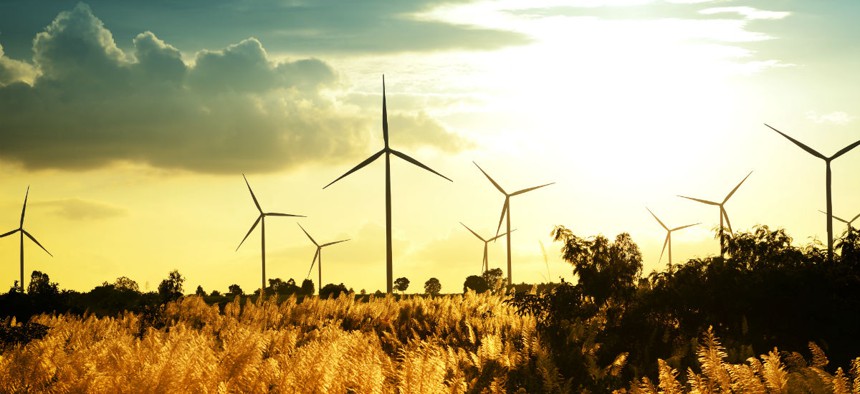The Uncertain Future of Federal Sustainability Programs
Work continues, despite the Trump administration’s antipathy toward the previous administration’s approach to climate change.
Long-time federal employees can remember a time when they were encouraged to wear short sleeve shirts in the summer. It was the 1970s, and the energy crisis was in full swing. To conserve resources, federal buildings ran warm in the summer and cool in the winter. Space heaters were banned in the interest of energy efficiency.
With the end of the national energy shortage, such efforts ultimately were re-cast and broadened to become “sustainability” initiatives. Given the Trump administration’s antipathy toward the previous administration’s approach to climate change and sustainability initiatives, there’s some question as to whether energy efficiency continue to be a federal priority in coming years.
A Bipartisan History
Federal energy efficiency initiatives over the past dozen years have been bipartisan affairs. For example, the 2005 Energy Policy Act set goals and standards to reduce energy use in existing and new federal buildings. This was followed in 2007 by a George W. Bush Administration executive order that expanded those goals. Congress, in turn, legislated these higher standards in the 2007 Energy Independence and Security Act and increased federal energy reduction goals to 30 percent by fiscal year 2015.
President Obama signed an executive order in 2009 that expanded the scope of these goals and required all federal agencies to appoint a senior sustainability officer to prepare and implement a Strategic Sustainability Performance Plan for the agency.
To create better cross-agency collaboration on meeting these goals and sustained high-level attention, Obama in 2014 designated these initiatives as one of the 15 cross-agency priority (CAP) goals, per a statutory requirement.
A third executive order, signed by Obama in 2015, updated the provisions of the two earlier directives, and set ambitious climate, energy, and environmental sustainability goals for federal agencies over the next decade because “the U.S. government must lead by example.” The higher goals set in this directive led to revisions to the CAP Goal to raise the bar.
CAP Goal on Climate Change
The actions begun under the CAP goal, “Climate Change (Federal Actions),” largely focus on federal government energy consumption and energy efficiency. The goal and subsequent actions set a series of targets for the government as a whole and for each agency to:
- Reduce direct federal greenhouse gas emissions by at least 40 percent by 2025 (from a 2008 baseline).
- Increase the government’s consumption of renewable electricity by 30 percent by 2025.
- Increase the use of performance-based contracting to improve energy and water efficiency in federal buildings by $4 billion, by the end of 2016.
- Reduce the greenhouse gas emissions of the government’s major suppliers, and monitor progress with a scorecard.
Governance Structure
Like the other CAP Goals, there is an overarching governance body to oversee the implementation of the goal. In this case, this body is housed in the White House Council on Environmental Quality’s Office of Federal Sustainability and is led by a Federal Chief Sustainability Officer. Its work is supported by agency-level chief sustainability officers who form the Interagency Sustainability Steering Committee. The Council and Office support four implementation teams, one for each of the sub-goals, each with different mixes of agency partners:
- Greenhouse Gas Emission reduction
- Renewable Electricity
- Performance Contracting
- Supply Chain Greenhouse Gas Emission Management
Progress to Date
While agency plans and progress status scorecards are no longer available on the cross-governmental performance.gov website, they are available on each agency’s site. For example, the Department of Energy’s fiscal year 2015 scorecard shows that it exceeded its targets in six of seven major categories. And its 2016 Strategic Sustainability Performance Plan makes measurable commitments to the 10 goals outlined in the 2015 executive order.
The governmentwide progress status report for the CAP Goal at the end of fiscal year 2016 noted measurable progress:
- By the end of 2015, direct greenhouse gas emissions from federal activities had declined 17.6 percent from the 2008 baseline.
- At the end of 2015, the original renewable electricity goal of 7.5 percent was exceeded; it was 8.3 percent of total electricity use (the 2015 executive order set a higher goal of 30 percent by 2025).
- The goal of committing at least $4 billion to performance-based contracting goal was exceeded.
According to the progress status report, in August 2016, the Army announced that it had completed contracting for $1 billion in energy-savings projects. The Army reported that in the previous five years, it had undertaken 127 energy-efficiency projects with the private sector, aimed at making energy-savings upgrades to federal buildings, noting that: “These upgrades will use long-term energy savings to pay for up-front costs, at no cost to taxpayers.”
The work of the Office of Federal Sustainability continues, as does the implementation of the goals set forth in the executive order.
Note: This is the final in a series about the progress of the 15 Cross-Agency Priority Goals announced in 2014.
NEXT STORY: The Trump Budget’s Assault on Federal Workers








